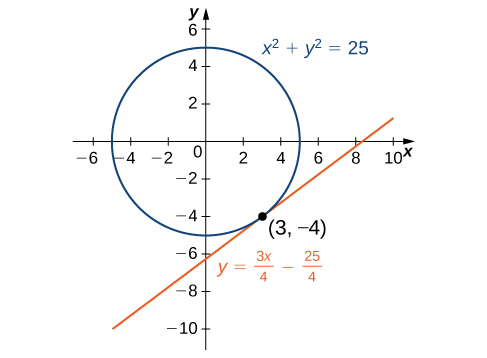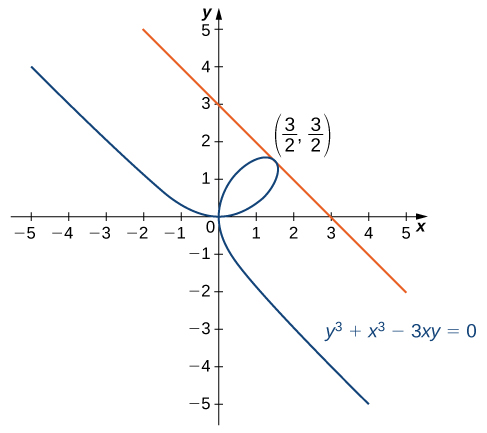Home
Calculus volume 1 Derivatives Implicit differentiation
Using implicit differentiation
Assuming that
y is defined implicitly by the equation
x
2
+
y
2
=
25
, find
d
y
d
x
.
Follow the steps in the problem-solving strategy.
d
d
x
(
x
2
+
y
2
)
=
d
d
x
(
25
)
Step 1. Differentiate both sides of the equation.
d
d
x
(
x
2
)
+
d
d
x
(
y
2
)
=
0
Step 1.1. Use the sum rule on the left.
On the right
d
d
x
(
25
)
=
0
.
2
x
+
2
y
d
y
d
x
=
0
Step 1.2. Take the derivatives, so
d
d
x
(
x
2
)
=
2
x
and
d
d
x
(
y
2
)
=
2
y
d
y
d
x
.
2
y
d
y
d
x
=
−2
x
Step 2. Keep the terms with
d
y
d
x
on the left.
Move the remaining terms to the right.
d
y
d
x
=
−
x
y
Step 4. Divide both sides of the equation by
2
y
.
(Step 3 does not apply in this case.)
Got questions? Get instant answers now! Got questions? Get instant answers now!
Using implicit differentiation and the product rule
Assuming that
y is defined implicitly by the equation
x
3
sin
y
+
y
=
4
x
+
3
, find
d
y
d
x
.
d
d
x
(
x
3
sin
y
+
y
)
=
d
d
x
(
4
x
+
3
)
Step 1: Differentiate both sides of the equation.
d
d
x
(
x
3
sin
y
)
+
d
d
x
(
y
)
=
4
Step 1.1: Apply the sum rule on the left.
On the right,
d
d
x
(
4
x
+
3
)
=
4
.
(
d
d
x
(
x
3
)
·
sin
y
+
d
d
x
(
sin
y
)
·
x
3
)
+
d
y
d
x
=
4
Step 1.2: Use the product rule to find
d
d
x
(
x
3
sin
y
)
.
Observe that
d
d
x
(
y
)
=
d
y
d
x
.
3
x
2
sin
y
+
(
cos
y
d
y
d
x
)
·
x
3
+
d
y
d
x
=
4
Step 1.3: We know
d
d
x
(
x
3
)
=
3
x
2
.
Use the
chain rule to obtain
d
d
x
(
sin
y
)
=
cos
y
d
y
d
x
.
x
3
cos
y
d
y
d
x
+
d
y
d
x
=
4
−
3
x
2
sin
y
Step 2: Keep all terms containing
d
y
d
x
on the
left. Move all other terms to the right.
d
y
d
x
(
x
3
cos
y
+
1
)
=
4
−
3
x
2
sin
y
Step 3: Factor out
d
y
d
x
on the left.
d
y
d
x
=
4
−
3
x
2
sin
y
x
3
cos
y
+
1
Step 4: Solve for
d
y
d
x
by dividing both sides of
the equation by
x
3
cos
y
+
1
.
Got questions? Get instant answers now! Got questions? Get instant answers now!
Using implicit differentiation to find a second derivative
Find
d
2
y
d
x
2 if
x
2
+
y
2
=
25
.
In
[link] , we showed that
d
y
d
x
=
−
x
y
. We can take the derivative of both sides of this equation to find
d
2
y
d
x
2
.
d
2
y
d
x
2
=
d
d
y
(
−
x
y
)
Differentiate both sides of
d
y
d
x
=
−
x
y
.
=
−
(
1
·
y
−
x
d
y
d
x
)
y
2
Use the quotient rule to find
d
d
y
(
−
x
y
)
.
=
−
y
+
x
d
y
d
x
y
2
Simplify.
=
−
y
+
x
(
−
x
y
)
y
2
Substitute
d
y
d
x
=
−
x
y
.
=
−
y
2
−
x
2
y
3
Simplify.
At this point we have found an expression for
d
2
y
d
x
2
. If we choose, we can simplify the expression further by recalling that
x
2
+
y
2
=
25 and making this substitution in the numerator to obtain
d
2
y
d
x
2
=
−
25
y
3
.
Got questions? Get instant answers now! Got questions? Get instant answers now!
Finding tangent lines implicitly
Now that we have seen the technique of implicit differentiation, we can apply it to the problem of finding equations of tangent lines to curves described by equations.
Finding a tangent line to a circle
Find the equation of the line tangent to the curve
x
2
+
y
2
=
25 at the point
(
3
,
−4
)
.
Although we could find this equation without using implicit differentiation, using that method makes it much easier. In
[link] , we found
d
y
d
x
=
−
x
y
.
The slope of the tangent line is found by substituting
(
3
,
−4
) into this expression. Consequently, the slope of the tangent line is
d
y
d
x
|
(
3
,
−4
)
=
−
3
−4
=
3
4
.
Using the point
(
3
,
−4
) and the slope
3
4 in the point-slope equation of the line, we obtain the equation
y
=
3
4
x
−
25
4 (
[link] ).
The line
y
=
3
4
x
−
25
4 is tangent to
x
2
+
y
2
=
25 at the point (3, −4). Got questions? Get instant answers now! Got questions? Get instant answers now!
Finding the equation of the tangent line to a curve
Find the equation of the line tangent to the graph of
y
3
+
x
3
−
3
x
y
=
0 at the point
(
3
2
,
3
2
) (
[link] ). This curve is known as the folium (or leaf) of Descartes.
Finding the tangent line to the
folium of Descartes at
(
3
2
,
3
2
)
.
Begin by finding
d
y
d
x
.
d
d
x
(
y
3
+
x
3
−
3
x
y
)
=
d
d
x
(
0
)
3
y
2
d
y
d
x
+
3
x
2
−
(
3
y
+
d
y
d
x
3
x
)
=
0
d
y
d
x
=
3
y
−
3
x
2
3
y
2
−
3
x
.
Next, substitute
(
3
2
,
3
2
) into
d
y
d
x
=
3
y
−
3
x
2
3
y
2
−
3
x to find the slope of the tangent line:
d
y
d
x
|
(
3
2
,
3
2
)
=
−1
.
Finally, substitute into the point-slope equation of the line to obtain
y
=
−
x
+
3
.
Got questions? Get instant answers now! Got questions? Get instant answers now!
Source:
OpenStax, Calculus volume 1. OpenStax CNX. Feb 05, 2016 Download for free at http://cnx.org/content/col11964/1.2
Google Play and the Google Play logo are trademarks of Google Inc.


